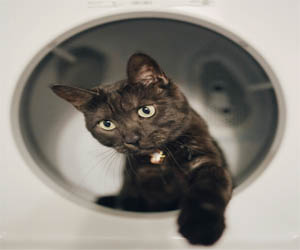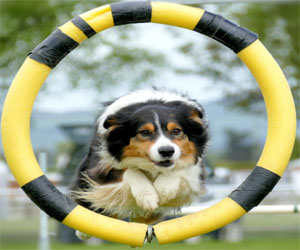


A Timeless Connection Of Love And Loyalty

The bond between humans and dogs is a remarkable and enduring one that has spanned centuries. Dogs have long been recognized as "man's best friend," and this deep connection is a testament to the love, loyalty, and companionship that these four-legged friends offer. In this article, we'll explore the profound and timeless human-dog bond, examining its significance, the factors that contribute to its strength, and the many ways it enriches the lives of both humans and their beloved canine companions.
A History Of Companionship: The history of the human-dog bond is a rich tapestry of cooperation and companionship. Dogs were among the first animals to be domesticated by humans, dating back thousands of years. Initially, dogs were utilized for hunting and protection, but over time, their roles expanded to include herding, guarding, and eventually becoming cherished family pets. This evolution of the dog's role in human society laid the foundation for the extraordinary bond we share today.
Factors That Strengthen The Bond:
Trust And Loyalty: Dogs are renowned for their unwavering loyalty. This trust and devotion between dogs and their owners build a strong foundation for the human-dog bond. The reliability of a dog's presence and affection creates a deep sense of security for their human counterparts.
Communication: Dogs are incredibly adept at understanding human body language, vocal cues, and emotions. This exceptional ability to communicate effectively with humans fosters a sense of mutual understanding and connection.
Emotional Support: Dogs offer comfort and emotional support in times of distress. Their empathetic nature allows them to sense when their owners are upset, providing a source of solace and companionship.
Physical Touch: The simple act of petting and cuddling with a dog releases oxytocin, the "love hormone," in both the dog and the human. This physical touch is a significant factor in strengthening the bond.
Shared Experiences: Whether it's going for a walk, playing fetch, or simply sitting together, the shared experiences between humans and dogs create lasting memories and reinforce the bond.
Enriching Lives: The human-dog bond offers countless benefits to both parties. For humans, the companionship of a dog can reduce stress, anxiety, and depression. Dogs provide a reason to get outside and exercise, which, in turn, improves physical health. Additionally, owning a dog promotes a sense of purpose and responsibility.
For dogs, the human bond provides a stable and loving environment. It offers mental stimulation, socialization, and the opportunity to be a valued member of the family. The bond with humans fulfills their need for social interaction and a sense of belonging.
Unconditional Love: Perhaps the most beautiful aspect of the human-dog bond is the unconditional love it entails. Dogs don't judge, hold grudges, or question their owners; they offer love and loyalty without reservation. This unwavering love creates a deep and lasting bond that brings immeasurable joy and fulfillment to the lives of those fortunate enough to experience it.
The human-dog bond is a treasure, a timeless connection that transcends words and spans generations. The trust, loyalty, communication, and unconditional love between humans and their canine companions are the cornerstones of this extraordinary relationship. The bond enriches the lives of both parties, providing companionship, comfort, and immeasurable joy. It's a bond that reminds us of the unique and profound connection that can exist between two different species, united by love and loyalty.
 Training The Mind: Achieving dream awareness, particularly in the form of lucid dreams, often requires practice and training. Techniques such as reality checks, dream journaling, and intention setting can help individuals become more aware within their dreams.
Training The Mind: Achieving dream awareness, particularly in the form of lucid dreams, often requires practice and training. Techniques such as reality checks, dream journaling, and intention setting can help individuals become more aware within their dreams.
Embracing Emotional Intensity: Dream awareness often heightens the emotional intensity of dream experiences. Dreamers can feel an array of emotions, from euphoria to terror, and explore the depths of their psyche. This emotional richness allows for self-reflection and insight.
Scientific And Psychological Perspective: From a scientific and psychological standpoint, dream awareness challenges our understanding of consciousness. It showcases that aspects of self-awareness can persist even in states of altered consciousness, like dreaming.
Nightmares And Dream Awareness: In the case of nightmares, dream awareness can be a double-edged sword. While it may lead to the recognition that one is dreaming, it can also intensify the fear and anxiety experienced within the dream. However, this heightened awareness can ultimately help individuals confront and process their fears.
Practical Applications: Dream awareness, especially in the form of lucid dreaming, has practical applications. It can be used to overcome phobias, rehearse important events, and explore creative ideas. Some even use it as a form of entertainment, creating their own vivid adventures.
Spiritual And Metaphysical Interpretations: Various spiritual and metaphysical traditions consider dream awareness as a connection to higher states of consciousness. Some believe that dreams provide insights into the soul, offering guidance, wisdom, and glimpses into the universal collective unconscious.
Self-Exploration And Personal Growth: Dream awareness serves as a valuable tool for self-exploration and personal growth. By analyzing dream narratives, symbols, and emotions, individuals can gain deeper insights into their subconscious, unresolved conflicts, and even receive solutions to waking-life challenges.






Unleashing The Potential Of Man's Best Friend
 Agility competitions are among the most popular forms of canine performance. In these events, dogs must navigate through a challenging obstacle course, showcasing their speed, dexterity, and responsiveness to their owner's commands. The bond and coordination between the dog and owner are truly remarkable, as they work together to complete the course successfully.
Agility competitions are among the most popular forms of canine performance. In these events, dogs must navigate through a challenging obstacle course, showcasing their speed, dexterity, and responsiveness to their owner's commands. The bond and coordination between the dog and owner are truly remarkable, as they work together to complete the course successfully.
Obedience competitions focus on a dog's ability to follow commands and exhibit self-control. Dogs are evaluated based on their precision in executing commands like sitting, staying, heeling, and more. These competitions highlight not only the dog's obedience but also their intelligence and the dedication of their owners to training.
Canine freestyle, a more creative form of performance, combines obedience, tricks, and dance. Dogs and their owners choreograph routines set to music, incorporating a medley of tricks, spins, and synchronized movements. These performances are an impressive display of the bond between dog and owner, as they dance and dazzle the audience.
Search and rescue demonstrations are another critical aspect of canine performance. These events showcase the extraordinary talents of dogs in finding and aiding individuals in various scenarios, such as disaster-stricken areas or in the wilderness. The commitment and courage of these working dogs and their handlers are awe-inspiring.
Beyond their entertainment value, canine performances offer numerous benefits to both dogs and their owners. For dogs, these activities provide essential exercise, mental stimulation, and socialization. They are a source of fulfillment, allowing dogs to tap into their natural instincts and abilities, which is crucial for their overall well-being.
Understanding Feline Body Language
 2. Ears:
2. Ears:
A cat's ears are highly expressive and provide valuable insight into their mood:
Forward And Upright: Ears in this position indicate alertness and interest. Your cat is engaged and focused on something.
Flat And Backward: When a cat's ears are flat against their head, it usually signifies fear, aggression, or annoyance. This is a sign that the cat feels threatened or agitated.
3. Whiskers:
Whiskers play a role in a cat's sensory perception and body language:
Relaxed And Fanned Out: Whiskers that are relaxed and fanned out indicate contentment and relaxation.
Pulled Back Tightly: When a cat's whiskers are pulled back tightly against their face, it's often a sign of fear or aggression. The cat is trying to make itself appear smaller and less threatening.
4. Eye Contact:
Cats use eye contact to convey various messages:
Slow Blinking: A slow blink from a cat is a sign of trust and affection. It's often referred to as a "cat kiss" and is reciprocated by cat owners as a sign of love.
Direct Stare: Prolonged and direct eye contact can be seen as a challenge or a threat in cat language. It's best to avoid sustained eye contact in such situations.
5. Posture:
A cat's overall body posture provides important clues to their feelings:
 Quality Time Together
Quality Time Together
Spending quality time with your pup is the foundation of a strong bond. Whether it's playing fetch in the park, going for long walks, or simply cuddling on the couch, these moments create lasting memories. Engage in activities your dog enjoys and be fully present, offering them your undivided attention.
Positive Reinforcement
Positive reinforcement is a powerful tool for strengthening the bond with your pup. Praise, treats, and affection when your dog exhibits desirable behavior enhance their trust in you. This not only encourages good behavior but also deepens the emotional connection between you and your pet.
Communication
Effective communication is essential for building a strong bond. Learn to understand your dog's body language and vocal cues. In turn, teach them commands, hand signals, and cues to establish clear, two-way communication. This mutual understanding fosters trust and respect.
Training And Consistency
Consistent training is a significant part of bonding. Dogs thrive on structure and routine. When you establish boundaries and expectations through consistent training, your pup feels secure and protected. It also strengthens the sense of partnership between you and your dog.
Affection And Grooming
Physical affection plays a vital role in building a strong bond. Regular petting, hugging, and gentle grooming sessions can be deeply reassuring for your pup. These actions not only provide comfort but also reinforce the love and trust between you.
Exploring Self-Hypnosis Techniques
 Self-hypnosis, also known as autohypnosis, empowers individuals to enter a hypnotic state on their own, without the assistance of a hypnotist. It can be a valuable tool for relaxation, personal growth, and addressing specific challenges. Here are some key self-hypnosis techniques to consider:
Self-hypnosis, also known as autohypnosis, empowers individuals to enter a hypnotic state on their own, without the assistance of a hypnotist. It can be a valuable tool for relaxation, personal growth, and addressing specific challenges. Here are some key self-hypnosis techniques to consider:
Find A Quiet Space: Begin by selecting a quiet, comfortable space where you can relax without distractions. Whether it's a cozy chair, a soft carpet, or even your bed, the key is to ensure you won't be interrupted during your self-hypnosis session.
Set An Intention: Determine the purpose of your self-hypnosis session. What specific issue or goal would you like to address or achieve? Having a clear intention will guide your self-hypnosis process.
Relaxation And Breathing: Sit or lie down in a comfortable position. Close your eyes and take a few deep, cleansing breaths. With each exhalation, release tension and stress. Slow, deep breathing can help induce a state of relaxation.
Visualization: Begin to visualize a calming and serene place. This could be a beach, a forest, or any location where you feel at peace. Imagine the sights, sounds, and sensations of this place. Visualization helps deepen your relaxation.
Progressive Muscle Relaxation: Progressively tense and then release the tension in each muscle group in your body, starting from your toes and moving upward. This can enhance your state of physical relaxation.
Affirmations And Suggestions: With your mind in a receptive state, use positive affirmations and suggestions related to your intention. For example, if you're seeking stress relief, you might say, "I am calm and in control." Repeat these affirmations while maintaining focus on your intention.
Counting Down: Some individuals find it helpful to count down from a specific number, such as 10 to 1, as they enter a deeper state of relaxation.
 Key Drivers: Several key factors have propelled the growth of renewable energy. First and foremost is the increasing public awareness of climate change and its consequences. Citizens are demanding action, pushing governments and corporations to commit to renewable energy solutions. Additionally, advancements in technology have made renewable energy sources more efficient and cost-effective, further fueling their adoption.
Key Drivers: Several key factors have propelled the growth of renewable energy. First and foremost is the increasing public awareness of climate change and its consequences. Citizens are demanding action, pushing governments and corporations to commit to renewable energy solutions. Additionally, advancements in technology have made renewable energy sources more efficient and cost-effective, further fueling their adoption.
Solar Power: Solar energy has witnessed a spectacular rise in popularity. Solar panels have become more affordable and accessible, making it possible for homeowners and businesses to harness the power of the sun. Photovoltaic technology has experienced exponential growth, transforming the way we generate electricity. The world's largest solar power plants can now produce vast amounts of clean energy, reducing our reliance on fossil fuels.
Wind Power: Wind energy has also made significant strides, with the construction of wind farms onshore and offshore. Advances in wind turbine design and engineering have improved efficiency and energy output. Countries with favorable wind conditions are harnessing this resource to meet their energy needs. Wind power has become a driving force in reducing greenhouse gas emissions.
Hydropower: Hydropower, one of the oldest forms of renewable energy, has been modernized with the development of more efficient turbines. Dams and hydroelectric power stations are providing a constant and reliable source of clean energy. The sustainability and low operational costs of hydropower make it an attractive option for many nations.
Challenges And Solutions: While the growth of renewable energy is impressive, challenges persist. Energy storage solutions, grid integration, and policy frameworks need to be continually improved to ensure a smooth transition. Innovation in battery technology, smart grids, and supportive government policies can address these issues.